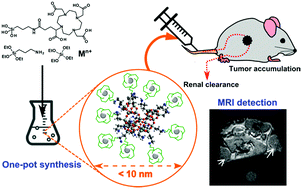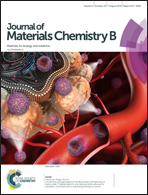One-pot direct synthesis for multifunctional ultrasmall hybrid silica nanoparticles†
Abstract
Ultrasmall silica nanoparticles (NPs), having hydrodynamic diameters under 10 nm are promising inorganic platforms for imaging and therapeutic applications in medicine. Herein is described a new way for synthesizing such kind of NPs in a one-pot scalable protocol. These NPs bear DOTA (1,4,7,10-tetraazacyclododecane-1,4,7,10-tetraacetic acid) ligands on their surface that can chelate different metals suitable for a wide variety of biomedical applications. By varying the ratio of the precursors, the hydrodynamic diameters of the particles can be controlled over the range of 3 to 15 nm. The resulting NPs have been characterized extensively by complementary techniques like dynamic light scattering (DLS), high performance liquid chromatography (HPLC), nuclear magnetic resonance (NMR), mass spectrometry (MS), phosphorescence titration, photophysical measurements, relaxometry and elemental analysis to elucidate their structures. Chelation of gadolinium (Gd) allowed its use as an effective intravenous contrast agent in MRI and was illustrated in mice bearing colorectal CT26 tumors. The new particle appears to sufficiently accumulate in the tumors and efficiently clear out of animal bodies through kidneys. This new synthesis is an original, time/material-saving and very flexible process that can be applied for creating versatile ultrasmall multifunctional nanomedicines.



 Please wait while we load your content...
Please wait while we load your content...